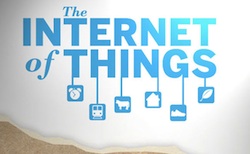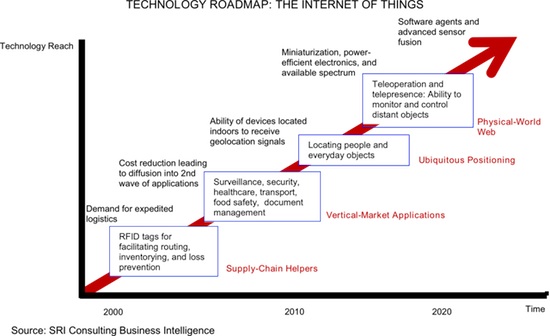The Internet of Things
William Gibson, the science fiction writer, author of Neuromancer and originator of the word "cyberspace," has just published a collection of his non-fiction work – as the book jacket puts it "reportage from the technological and cultural frontiers of the evolving world." The book is Distrust that Particular Flavor and it's a gem.
In an article, "Will We Have Computer Chips in our Head," written in 2000 for Time, Gibson comments: "I very much doubt that our grandchildren will understand the distinction between that which is a computer and that which isn't. Or to put it another way, they will not know ‘computers' as any distinct category of object or function. This, I think, is the logical outcome of genuinely ubiquitous computing: the wired world. The wired world will consist, in effect, of a single unbroken interface. The idea of a device that 'only' computes will perhaps be the ultimate archaism in a world in which the fridge or the toothbrush are potentially as smart as any other object, including you."
 A year before this article was written, the term "The Internet of Things" had been coined by Kevin Aston of MIT's Auto-ID center. The concept immediately began moving into the Zeitgeist.
A year before this article was written, the term "The Internet of Things" had been coined by Kevin Aston of MIT's Auto-ID center. The concept immediately began moving into the Zeitgeist.
Today your toothbrush may not be as smart as you are, but the Internet of Things (IoT) is progressing nicely. The Wikipedia definition of the term is succinct: "The Internet of Things refers to uniquely identifiable objects (things) and their virtual representations in an Internet-like structure."
The government in the UK is taking the concept seriously. It dipped into its Technology Strategy Board (TSB) slush fund and gave £50,000 to each of ten firms to create apps and services associated with the IoT. The idea is to attach a small chip to products to wirelessly store, transmit and receive real time information, blurring the distinction between the digital and physical world. TSB plans to follow up the initial research with a £4m to extol the benefits of merging applications and services via the IoT.
In France, the research establishment, Instituts Carnot has issued a white paper titled Smart Networked Objects and Internet of Things, which takes an ever broader view of the practice and potential of IoT.
The paper's executive summary states, "We now see the deployment of a new generation of networked objects with communication, sensory, and action capabilities (wireless information transport networks, RFID, WSAN, etc.) for numerous applications. But the interconnection of objects having advanced processing and connection capabilities is expected to lead to a revolution in terms of service creation and availability and will profoundly change the way we interact with the environment. In short the physical world will merge with the digital/virtual world."
Achieving even a rudimentary IoT is not going to be easy. The white paper points out that a "pluridisciplinary" approach to develop the requisite new technologies, concepts, and models is needed. This includes IC development, energy management, communications systems and principles, embedded systems, and packaging data acquisition and processing. Key challenges include:
- Integration of smart, autonomous interconnected objects such as sensors, actuators and processors working under severely constrained energy and physical environments
- Coping with the potentially trillions of objects that can be interconnected over secure, flexible networks providing secure and ubiquitous service provisioning
- Accomplishing the fusion of the data obtained by sensors, network and service management, distributed data treatment, and ambient intelligence
The Carnot Institutes white paper is the offshoot of a joint initiative between the Institute and a variety of European research centers, academic institutions and industry (including companies such as Orange, Alcatel Lucent, Thales, Schneider Electric, Airbus and Auchan). It's worth reading.
For a little more breathless, but still comprehensive coverage of the topic, Cisco's Dave Evans has written a white paper titled The Internet of Things: How the Next Evolution of the Internet is Changing Everything. His stated goal is to "educate you in plain and simple terms so you can be well versed in IoT and understand its potential to change everything we know to be true today."
According to Evans, "IoT represents the next evolution of the Internet, taking a huge leap in its ability to gather, analyze, and distribute data that we can turn into information, knowledge, and, ultimately, wisdom. In this context, IoT becomes immensely important."
He continues, "Already, IoT projects are under way that promise to close the gap between poor and rich, improve distribution of the world's resources to those who need them most, and help us understand our planet so we can be more proactive and less reactive. Even so, several barriers exist that threaten to slow IoT development, including the transition to IPv6, having a common set of standards, and developing energy sources for millions—even billions—of minute sensors."
HP's Intelligent Infrastructure Lab is one of the many companies rising to the challenge. It has created CeNSE charged with this mission: "Create the mathematical and physical foundations for the technologies that will form a new information ecosystem, the Central Nervous System for the Earth (CeNSE), consisting of a trillion nanoscale sensors and actuators embedded in the environment and connected via an array of networks with computing systems, software and services to exchange their information among analysis engines, storage systems and end users."
For manufacturers, the IoT means bringing a new perspective to the design, manufacture and marketing of IoT related products. No longer can these products be regarded as discrete objects; instead their form and function will reflect their status as part of a vast web of interacting systems, the whole affecting the functioning of the parts and the parts, in turn, impacting the functioning of the whole.
 The Buddhist monk, poet and scholar, Thich Nhat Hahn uses the term "inter-are" to describe the interconnectedness of all life. Now that the world of things is undergoing much the same transformation, we may have trouble determining where we leave off and our intelligent, interconnected appliances begin.
The Buddhist monk, poet and scholar, Thich Nhat Hahn uses the term "inter-are" to describe the interconnectedness of all life. Now that the world of things is undergoing much the same transformation, we may have trouble determining where we leave off and our intelligent, interconnected appliances begin.
One thing is certain, in this new wired world HP's Evans is right: nothing will ever be the same.











